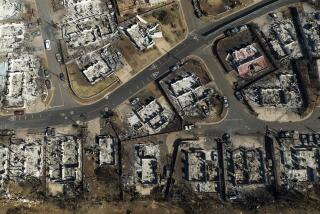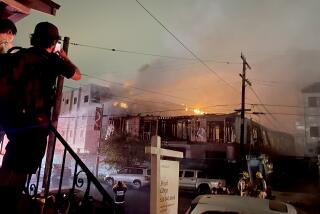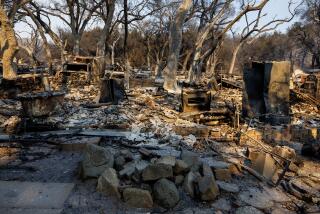Laguna’s Fire Victims Fare Well on Insurance : Recovery: While some claims disputes have arisen, complaints have been fewer than in other ravaged areas.
LAGUNA BEACH — As the city grapples with rebuilding a year after the disastrous firestorm that consumed some 400 homes, it can count one stroke of fortune: Homeowners have fared better with the insurance industry than other scorched Southland communities have.
State regulators and many of the city’s fire victims give reasonably good marks to insurers, who have processed nearly 2,600 claims totaling more than $350 million in the aftermath of the Laguna blaze.
The state Department of Insurance has recorded fewer complaints from homeowners in Laguna Beach than from the Malibu and Altadena areas savaged by similarly catastrophic fires last October. While the Insurance Department fielded 17 complaints from Laguna fire victims, they handled 78 after the blazes in the two Los Angeles County communities.
“I’m very happy the way the industry has responded to the majority of folks in Laguna,” said state Sen. Art Torres, chairman of the Senate Insurance Committee and Democratic candidate for insurance commissioner. “The majority of cases were or are being resolved. I just wish it was the same way elsewhere.”
With the first anniversary of the disaster at hand, 98% of the claims in Laguna have resulted in at least a partial settlement. The three biggest insurers in the area--State Farm, Allstate and Farmers Insurance--have paid out nearly $195 million so far.
“There’s been problems with some of the smaller companies, but on balance Laguna Beach came out very well,” said Jerry Cohen, a retired engineer whose home was destroyed in the blaze.
Many feared it wouldn’t be that way. After the firestorm obliterated his small Canyon Acres cottage last October, Terence (Chuck) Gibian turned anxiously to his insurance company for help. Like other victims in Laguna, he had heard insurance horror stories after the 1991 fire in Oakland Hills, in which many homeowners discovered they were woefully underinsured and couldn’t afford the cost of rebuilding.
Gibian’s consternation, however, quickly turned to calm. His agent arrived with a healthy bailout check “before the smoke stopped rising.” The firm offered guidance on architects. They also agreed to pay the full price of rebuilding his house, including the extra foundation work and other upgrades needed to meet today’s tighter codes.
“The insurance companies got yelled at after Oakland,” Gibian said. “In Laguna, a lot of them have made accommodations. I think they wanted to recoup some of their lost reputation.”
Local residents and state officials cite a variety of reasons that Laguna Beach did better with insurers than other Southland areas.
Many of the homeowners in Altadena and Malibu, two regions considered high-risk because of a history of wildfires, don’t have the sorts of top-shelf policies that provide guaranteed replacement of a home, including the costly structural upgrades necessary to meet present-day building codes. In such areas, those homeowners are covered under the California FAIR plan, a quasi-public insurance program that provides limited coverage to residents in high-risk zones. Typically, FAIR policies only cover a portion of the cost of rebuilding, a level of protection that one state insurance official described as “mediocre.”
In sharp contrast, Laguna Beach has not been plagued by costly wildfires and was not designated a FAIR zone, meaning homeowners there were able to obtain the best policies private insurance companies offer.
A recent survey of homeowners in Mystic Hills, one of the neighborhoods hardest hit in the Laguna blaze, found that 59% of the residents had policies that financed full replacement of their homes. Another 16% were paid based on a market appraisal of their homes’ worth before the blaze, a figure that normally doesn’t cover the entire cost of rebuilding. Meanwhile, 19% were paid based on fixed values declared in their policies, while 6% had yet to be paid, even up to the limits set in their insurance premiums.
Aside from the peculiarities of the insurance industry, a variety of other factors came into play to help Laguna Beach. Early on, local and state politicians weighed in on behalf of the victims of the fire. Soon after the flames subsided, state Sen. Marian Bergeson (R-Newport Beach), whose district includes Laguna Beach, joined Torres at a well-attended meeting at a local church. Consumer groups that flowered after the Oakland fire also made the trip, offering warnings and advice.
But the insurance industry, which saw its reputation scorched along with the hillsides in the Oakland firestorm, also deserves credit.
After Oakland, insurers were faulted for failing to inform consumers about the limits of their coverage, shuttling adjusters around so that consumers could not get consistent treatment, giving “low-ball” estimates of rebuilding costs, providing inadequate advance payments for fire victims’ living expenses and needlessly dragging out the claims settlement process.
The industry continues to dispute most of those charges. “People who knowingly opted for lower policy limits in order to save a couple dollars on their premium came back with all kinds of reasons why they should be paid far in excess of their policy limits,” said Jim Snyder, president of the Personal Insurance Federation of California, an umbrella group representing many of the industry’s largest companies. “The tragedy was used by many as a windfall for betterment.”
Still, after the Oakland Hills fire many of the firms launched programs to better communicate the fine details of their policies and to rewrite policies of homeowners whose limits weren’t close to covering the cost of replacing a house.
When the fires hit Laguna and other spots around the Southland, many insurance companies reacted with dispatch. A number called in additional adjusters from around California or out of state and established toll-free claims hot lines. They stationed representatives at disaster relief centers. Several also changed their claims handling procedures to designate a single person as responsible for each file, so consumers would be assured of continuity.
While industry advocates such as Snyder bemoan what they saw as opportunism by some victims of the Oakland fire, several insurance firms took the politically safe route in Laguna and ratcheted up coverage after the fact for burned-out residents whose policies were too limited to restore what they lost. Such concessions came in Oakland only after intense political pressure was exerted on the insurance industry.
But experts say a number of problems have persisted. Cindy Ossias, an Insurance Department senior staff counsel, said some firms weren’t working fast enough to upgrade policies and were sticking to replacement formulas that drastically undervalued the cost of rebuilding a custom home on a hillside lot.
Moreover, some victims who have recouped full replacement value for their structures have not received enough to replace their personal belongings--clothes, furniture, carpets, TVs, personal computers and such--that went up in smoke. Policies typically set a replacement level for belongings at 75% of the cost of rebuilding the house, but critics say that figure is arbitrary and doesn’t always cover the losses.
Consider the case of Robert F. Gentry. The Laguna Beach councilman, who saw not only his personal residence burn down but also a nearby rental house he owns, has experienced a “roller-coaster ride” of both good and bad in dealing with his insurance company.
Negotiations that Gentry describes as “creative tension” culminated with the insurer agreeing to bump up his policy limits to a level that he hopes will cover the cost of rebuilding. The company also agreed to honor the city’s domestic partnership registry and cover the cost of replacing the belongings of Gentry’s partner, Dennis Amick.
But then there’s the bad part. Even with his final settlement, Gentry is still $100,000 short on his belongings, mostly because he had amassed a house full of family antiques that included 17th-Century Victorian furniture, silver, art pieces and marble statuary. His insurer also refused to continue offsetting the $1,550 in monthly income he was losing on his burned-out rental, which is just now under construction.
Gentry, a philosophical sort, chalks it up to “lessons in life” and adds: “I’m a much better insurance consumer today than I was a year ago.”
A neighbor of Gentry’s has a grimmer tale with a happier ending. Two weeks before the fire erupted, Bill Halbert talked to his insurer about getting a full replacement plan. When the flames consumed the 2,500-square-foot view home, Halbert breathed a sigh of relief knowing he had gotten the upgraded policy just in time.
But a few weeks later the insurance firm called to tell the 54-year-old health care marketing executive that the company didn’t believe he had signed up and were not going to honor the new policy. His old policy limit would pay maybe half the rebuilding cost.
“Devastated is not exaggerating the way we felt,” recalls Halbert, who had raised three children in the house with his wife, Ginny. “It seemed like the whole rest of our lives was in jeopardy.”
Halbert got an attorney and ultimately the case was taken to arbitration, where a judge ruled last month against the insurance firm, USAA, which provides coverage to active and retired military personal and their families. “It’s the first sigh of relief we’ve had in over a year,” said Halbert, a former Army officer.
Although the firm still believes it was correct, it has abided by the arbitration judge’s decision and issued the Halberts a check reflecting the new limits, said Paul Schattenberg, a USAA spokesman. He also noted that the firm settled 131 claims in the Laguna fire--including 29 total losses--at a cost of $42.6 million without problems and maintains one of the lowest complaint ratios in California.
Some victims remain in a tug of war. In a case reminiscent of the insurance struggles after the Oakland Hills fire, Bernard and Mary Anderson have sued their insurer, Aetna Casualty & Surety Co., claiming they put their faith in the firm’s representatives to provide them with adequate coverage. Instead, the $193,000 of limits will only partially cover replacement of the house. Aetna had no comment on the case.
Even some fire victims who ultimately reached a satisfactory settlement with their insurers said they were troubled by the negotiation process. One resident of Canyon Acres, who asked for anonymity for fear of reprisals from his insurer, said he was continually put on the defensive and chastised for not keeping records of his belongings somewhere besides his house, which burned to the ground.
Others who kept good records didn’t suffer such a fate. David Horne, president of the Mystic Hills Homeowners Assn., had stowed in a bank safe deposit box complete lists, receipts and a videotape documenting his belongings. The last thing Horne’s wife did as flames raced toward their house was go around snapping photos for further proof.
A few said they felt the Northridge earthquake, which dwarfed the fires both in terms of victims and property loss, prompted insurers to make quick concessions.
“The earthquake helped, I think, in the sense that some firms didn’t have time to deal with Laguna in detail,” said Cohen, whose insurance carrier had three total losses in the Laguna Beach fire but more than 40,000 claims in the earthquake. “Everything was liberalized in favor of the homeowner.”
* POLICY RENEWALS DENIED: Some in Laguna lose fire insurance as firms reduce risks. A18
Insuring the Losses
Five of the largest insurance companies in the nation are still processing claims filed by Laguna Beach homeowners and businesses. The status:
Company Claims filed Claims settled Claim values* Farmers 410 340 $67.9 State Farm 505 417 65.8 Allstate 174 n/a 61.0 Chubb 102 85 10.0 Fireman’s Fund 98 96 Not released
* In millions of dollars
N/A: Information not available
Sources: Individual insurance companies
Researched by CAROLINE LEMKE / Los Angeles Times
More to Read
Sign up for Essential California
The most important California stories and recommendations in your inbox every morning.
You may occasionally receive promotional content from the Los Angeles Times.









